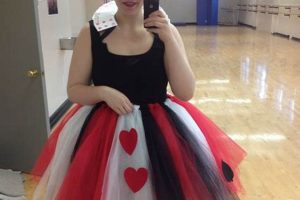The creation of an underwater diving outfit from readily available materials constitutes a cost-effective and personalized approach to celebratory attire. This method enables individuals to simulate the appearance of a deep-sea diver using items such as repurposed containers, tubing, and dark-colored clothing, often enhanced with painted details and homemade accessories.
This form of creative construction offers a tangible outlet for imaginative expression and resourcefulness. Beyond the purely aesthetic, this approach fosters an understanding of basic design principles and material manipulation. Historically, such endeavors have served as accessible means of participation in costume-related events, particularly where budget constraints exist or unique character portrayals are desired.
The following sections will detail various techniques and material choices applicable to the successful fabrication of simulated underwater diving apparel. Emphasis will be placed on safety considerations and methods for achieving visually compelling results.
DIY Scuba Costume
The following guidelines offer practical advice for creating a visually authentic and structurally sound simulated underwater diving ensemble. Adherence to these recommendations can enhance the overall impact and durability of the finished product.
Tip 1: Material Selection: Prioritize lightweight, durable plastics for simulated air tanks and regulators. Recycled plastic bottles or containers offer a readily available and cost-effective solution. Ensure all materials are clean and free from sharp edges to minimize potential injury.
Tip 2: Color Palette Consistency: Maintain a consistent color scheme throughout the costume. Dark colors, such as black, navy blue, or dark gray, typically emulate the appearance of authentic underwater diving suits. Metallic silver or gray paint can simulate the look of metal components.
Tip 3: Regulator Fabrication: Construct the regulator from flexible tubing and appropriately sized plastic connectors. Paint the connectors to resemble metal fittings and ensure the tubing is securely attached to prevent detachment during wear. Consider using corrugated tubing for enhanced visual realism.
Tip 4: Tank Attachment Method: Secure the simulated air tanks to a harness or vest using strong adhesive or straps. Distribute the weight of the tanks evenly across the wearer’s back to prevent discomfort or strain. Test the attachment method thoroughly before prolonged use.
Tip 5: Mask and Goggle Integration: Incorporate a pair of clear goggles or a modified plastic face shield to simulate the diving mask. Attach the goggles securely to the head using an adjustable strap. Ensure the wearer’s vision is not obstructed and that the mask fits comfortably.
Tip 6: Fin Construction: Craft simulated fins from stiff cardboard or foam board. Cut the fins to the appropriate shape and size, and reinforce the edges with tape or fabric. Attach the fins to the wearer’s footwear using straps or elastic bands.
Tip 7: Detailing and Embellishments: Add realistic details to the costume using paint, markers, or adhesive labels. Replicate gauges, dials, and other diving equipment features to enhance the visual appeal. Reference photographs of actual underwater diving gear for accurate representation.
These guidelines underscore the importance of careful planning, material selection, and construction techniques in achieving a convincing and durable simulated underwater diving outfit. Attention to detail and adherence to safety precautions are paramount throughout the fabrication process.
The subsequent sections will explore variations in construction techniques and strategies for personalizing the simulated underwater diving ensemble.
1. Material Selection
Material selection constitutes a fundamental aspect of constructing a simulated underwater diving outfit, directly influencing the costume’s visual fidelity, durability, and wearer comfort. The choice of materials determines the feasibility of replicating the appearance of professional underwater diving gear while remaining within budgetary and accessibility constraints.
- Weight Considerations
The mass of constituent materials directly impacts the wearer’s mobility and comfort. Heavy materials, such as dense metals or thick plastics, can cause fatigue and restrict movement. Therefore, lightweight alternatives, including thin-walled plastic containers and foam board, are often preferred for simulating air tanks and fins. A light construction enhances the wearer’s ability to comfortably navigate and participate in events.
- Visual Realism
Material selection plays a key role in achieving visual accuracy. Smooth, dark-colored plastics effectively mimic the appearance of authentic underwater diving suit components. Metallic paints applied to plastic elements simulate the gleam of metal fittings and regulators. The tactile properties of chosen materials contribute to the overall impression; for example, flexible tubing approximates the feel and appearance of regulator hoses.
- Durability and Longevity
The chosen materials must withstand the intended use environment and exhibit resistance to damage. Fragile materials, such as thin cardboard, are susceptible to tearing and deformation, particularly during active wear. Durable plastics and reinforced fabrics offer greater resistance to wear and tear, extending the costume’s lifespan. Proper reinforcement techniques, such as taping edges or applying adhesive coatings, can enhance the durability of less robust materials.
- Safety Implications
Material selection directly affects the safety of the wearer. Sharp edges, toxic substances, and flammable materials pose potential hazards. Non-toxic paints, rounded edges on plastic components, and flame-retardant fabrics minimize the risk of injury or adverse reactions. Prioritizing safety considerations throughout the selection process is essential to ensure the wearer’s well-being.
In summary, thoughtful material selection is vital for a successful simulated underwater diving ensemble. Balancing visual realism, durability, weight considerations, and safety implications is paramount. The choice of materials significantly impacts the costume’s overall effectiveness and its suitability for intended use.
2. Color Consistency
Color consistency is a critical factor in achieving a convincing and aesthetically pleasing simulated underwater diving ensemble. It directly influences the perceived realism and professionalism of the finished product. Variations in color can detract from the overall effect and diminish the intended illusion.
- Material Uniformity
Maintaining a consistent color palette across all
costume components is essential. Disparate shades of similar colors can create a disjointed and amateurish appearance. Sourcing materials from the same dye lot, or using paints within the same color family, helps ensure visual harmony. For instance, if the simulated air tanks are painted a dark gray, the regulator and other accessories should ideally match or complement that specific shade of gray. - Light and Shadow Simulation
Accurate representation of underwater environments requires understanding how light interacts with color. Colors appear muted and desaturated at greater depths. Incorporating subtle variations in shade and tone can enhance the illusion of depth and realism. For example, applying a slightly darker shade to the lower portions of the simulated air tanks can suggest the presence of shadow and create a more three-dimensional effect.
- Diver Equipment Standards
Adhering to the color conventions commonly associated with professional underwater diving equipment contributes to the authenticity of the costume. Black, navy blue, and dark gray are frequently used in underwater diving suits and accessories. Replicating these color schemes enhances the costume’s credibility. Deviations from these established standards can create a less convincing or even comical impression.
- Paint Application Techniques
The application of paint or dye must be consistent to avoid visible streaks, blotches, or uneven color distribution. Applying multiple thin coats of paint, rather than a single thick coat, typically yields a smoother and more uniform finish. Proper surface preparation, such as sanding or priming, can improve paint adhesion and prevent color irregularities. Consistent painting also applies to how colors are chosen, ensuring a consistent visual language.
These factors demonstrate how color consistency, executed with attention to detail and an understanding of underwater visual dynamics, significantly elevates the overall impact of a “diy scuba costume”. Consistency across materials, accurate simulation of light and shadow, adherence to established equipment standards, and proper paint application techniques collectively contribute to a more believable and professional-looking result.
3. Regulator Design
Regulator design is a pivotal element in the construction of a simulated underwater diving ensemble, directly impacting the costume’s believability and overall aesthetic appeal. While a functional regulator controls air flow in actual underwater diving apparatus, a simulated regulator serves a purely visual purpose in a “diy scuba costume”.
- Form and Function Analogy
A simulated regulator attempts to replicate the form of its functional counterpart, capturing key design elements such as multiple stages, pressure gauges, and mouthpiece connections. The fidelity of this replication contributes significantly to the costume’s realism. For example, using appropriately sized tubing and fittings to mimic the high-pressure and low-pressure hoses enhances the visual authenticity. Failure to capture these analog design elements degrades the overall effect.
- Material Selection for Visual Impact
The choice of materials directly affects the simulated regulator’s visual impact. Metallic paints or coatings applied to plastic components can emulate the appearance of metal construction, increasing the perceived quality. Furthermore, different textures can be employed to differentiate between various regulator components, such as smooth hoses versus textured housings. Using materials that closely resemble the appearance of those used in real regulators strengthens the illusion.
- Ergonomic Considerations (Simulated)
Although a simulated regulator is non-functional, incorporating elements of ergonomic design can improve the costume’s wearability and appearance. For instance, positioning the simulated mouthpiece in a natural and comfortable location enhances the overall impression of authenticity. Furthermore, ensuring that the simulated regulator does not obstruct the wearer’s vision or movement is crucial for safety and comfort. Mimicking the ergonomic principles of a functional regulator contributes to a more convincing result.
- Safety and Structural Integrity
While primarily visual, a simulated regulator should be constructed with safety in mind. Sharp edges, flimsy connections, or potentially hazardous materials should be avoided. The regulator should be securely attached to the mask or other costume components to prevent accidental detachment or injury. Structural integrity ensures the regulator maintains its shape and appearance throughout the duration of use. Safety and structural considerations, therefore, are integral to effective simulated regulator design.
The design of the regulator in a “diy scuba costume”, while purely aesthetic, is crucial for realizing a convincing illusion. By considering factors such as form and function analogy, material selection, ergonomic considerations, safety, and structural integrity, a more realistic and visually appealing result can be achieved. The regulator, therefore, represents a significant component in the overall success of the costume’s presentation.
4. Tank attachment
The method of securing simulated air tanks to the wearer is a critical aspect of any credible imitation underwater diving outfit. In a “diy scuba costume”, the tank attachment mechanism not only contributes to the visual authenticity but also significantly affects the comfort, safety, and overall wearability of the ensemble. An inadequate or poorly designed attachment system can detract from the aesthetic appeal and pose potential hazards to the wearer.
Effective tank attachment involves careful consideration of weight distribution, stability, and ease of movement. Simulated tanks, even when constructed from lightweight materials, can become cumbersome if not properly supported. Harnesses, vests, or strategically placed straps serve as viable attachment solutions, distributing the weight across the wearer’s torso. Real-world examples include the use of adjustable backpack straps repurposed to create a secure and comfortable tank support system. The placement and adjustability of these straps are paramount, ensuring the tanks remain firmly in position without restricting the wearer’s range of motion. Furthermore, quick-release mechanisms, though simulated, can provide a degree of safety, allowing for rapid removal of the tanks in the event of an emergency or discomfort.
In conclusion, tank attachment is not merely an aesthetic detail, but a functional element that influences the success and safety of a created underwater diving simulation. The implementation of a well-engineered attachment system demonstrates attention to detail and enhances the overall impression of realism. Proper weight distribution, stability, and the inclusion of safety features contribute significantly to a comfortable and visually convincing result, reinforcing the importance of tank attachment within the broader context of underwater diving outfit creation.
5. Mask Integration
The integration of a mask within a simulated underwater diving outfit represents a crucial element in achieving a convincing visual representation. The mask, as a defining feature of underwater diving equipment, significantly contributes to the overall realism and believability of a “diy scuba costume.” Its presence immediately establishes the intended character and enhances the immersive effect for both the wearer and observers. For instance, a modified plastic face shield, secured with adjustable straps and appropriately colored, can effectively simulate a professional-grade underwater diving mask. Incomplete or poorly executed mask integration diminishes the intended effect and undermines the costume’s credibility.
Effective mask integration requires consideration of several factors, including appropriate material selection, secure attachment methods, and visual accuracy. The chosen material should be lightweight and durable, ensuring both comfort and longevity. A clear plastic face shield or modified goggles are commonly employed, offering a balance between visibility and aesthetic appeal. Secure attachment mechanisms, such as adjustable straps or elastic bands, are essential for maintaining the mask’s position and preventing slippage during wear. Accurate representation of mask design, including replicating features like the lens shape, frame structure, and sealing surfaces, contributes to the overall visual fidelity. A contrasting example would be using sunglasses, which lacks the proper visual queues and makes the entire costume less effective.
Therefore, careful attention to mask integration is essential for the success of any “diy scuba costume.” The mask serves as a focal point, drawing the eye and establishing the character. Appropriate material selection, secure attachment, and visual accuracy are key considerations. Neglecting these aspects compromises the overall effect and reduces the impact of the costume. Proper mask integration transforms a collection of disparate elements into a cohesive and convincing representation of underwater diving gear, underscoring its fundamental importance in achieving the desired outcome.
6. Fin construction
Fin construction constitutes a critical element within the broader scope of creating a simulated underwater diving outfit. The fins, readily identifiable as essential underwater propulsion devices, immediately signify the intended representation. Therefore, their accurate and considered fabrication significantly impacts the overall effectiveness and believability of a “diy scuba costume”. The absence of properly constructed fins, or the substitution with unsuitable alternatives, noticeably detracts from the costume’s visual accuracy and its success in conveying the intended underwater diver persona. Real-life examples include using stiff cardboard cut into the characteristic shape and attached to footwear, or employing repurposed rubber sheeting for a more flexible approximation. The former showcases simple construction, while the latter enhances realism. This exemplifies the importance of tailored techniques to realize a convincing simulated underwater diving ensemble.
The materials employed in fin construction largely determine the realism and durability of the simulated underwater diving fins. Stiff but lightweight materials, such as foam board or corrugated plastic, allow for maintaining the fin’s characteristic shape while minimizing added weight. The method of attachment to the wearer’s feet also warrants consideration. Securing the simulated fins with adjustable straps or elastic bands allows for a more comfortable and secure fit, enabling greater freedom of movement. For instance, securely fastened fins allow for more realistic gait and posture and avoids causing undue fatigue. The proper alignment and secure fitting prevent slippage or detachment during wear, potentially disrupting the costume’s aesthetic impact and posing a tripping hazard. A failed attempt to accurately reproduce fins will cause a distraction.
In conclusion, fin construction represents a fundamental aspect of any endeavor involving a realistic underwater diving outfit recreation. The design and construction influence the overall success of the “diy scuba costume”. Challenges in material selection and attachment methods must be overcome to achieve a visually compelling and structurally sound result. By prioritizing the fin’s accurate representation, the constructed outfit conveys a more believable and complete image of an underwater diver, thereby enhancing its overall impact and effectiveness.
Frequently Asked Questions
The following addresses frequently encountered inquiries regarding the construction and implementation of simulated underwater diving ensembles.
Question 1: What is the optimal material for simulating air tanks in a DIY scuba costume?
Lightweight, rigid plastics such as repurposed plastic bottles or PVC pipes are generally recommended. These materials provide structural integrity without adding excessive weight, which can compromise comfort and mobility.
Question 2: How should simulated regulators be attached to a DIY scuba costume?
Secure attachment methods, such as strong adhesives or durable straps, are essential. The regulator should be positioned in a manner that emulates its real-world counterpart while ensuring it does not obstruct vision or movement.
Question 3: What measures can enhance the realism of simulated fins in a DIY scuba costume?
Employing rigid but pliable materials, like foam board or corrugated plastic, is crucial. Precise shaping and painting to mimic authentic underwater diving fin designs are also recommended. Secure attachment to footwear is paramount for both realism and safety.
Question 4: What color scheme should be followed when constructing a DIY scuba costume?
Dark shades, such as black, navy blue, and dark gray, are generally preferred due to their prevalence in actual underwater diving equipment. Metallic accents, using silver or gray paint, can further enhance the costume’s visual fidelity.
Question 5: Is it possible to create a visually convincing DIY scuba costume on a limited budget?
Yes, resourcefulness is key. Repurposing readily available materials, such as cardboard, plastic containers, and fabric scraps, can significantly reduce costs. Creative painting and detailing techniques can enhance the aesthetic appeal without requiring expensive components.
Question 6: What safety precautions should be observed when creating and wearing a DIY scuba costume?
Sharp edges should be eliminated from all components. Materials used should be non-toxic and non-flammable. The costume should not impede vision or movement. Regular inspections for wear and tear are recommended to prevent accidents.
Careful planning and attention to detail are essential for producing a successful and visually authentic simulated underwater diving ensemble.
The subsequent discussion will address the potential for personalizing simulated underwater diving gear.
Conclusion
The preceding discussion explored the multifaceted aspects of creating a simulated underwater diving ensemble. Detail was given to material selection, color consistency, regulator design, tank attachment, mask integration, and fin construction. These elements, when carefully considered and executed, contribute significantly to the visual authenticity and overall success of the “diy scuba costume”.
The construction of a simulated underwater divin
g outfit offers an opportunity for creative expression and resourceful problem-solving. Aspiring designers and hobbyists should leverage the provided information to develop innovative and visually compelling representations of underwater diving equipment. Further exploration and experimentation will undoubtedly lead to advancements in the art of simulated underwater diving ensemble creation, enhancing the realism and accessibility of this unique form of costume design.







